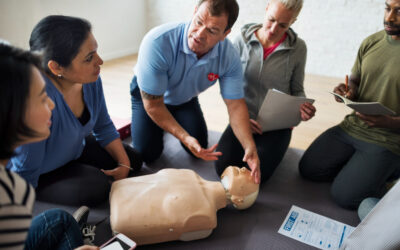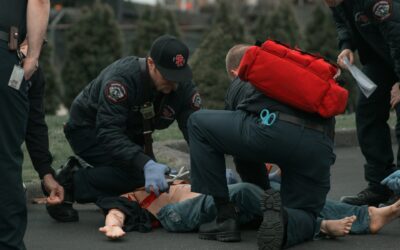When you arrive at the scene of any emergency with multiple victims, you likely know that the first step is triage—assess who needs the most urgent, immediate care (not necessarily the first patient you see).
But it’s easy to feel momentarily overwhelmed, especially during mass casualty incidents (MCIs) when resources are limited. Relying on an effective EMS triage system is crucial to ensure the best possible outcomes for the most patients. Fortunately, there are clear steps to help you perform fast EMS triage confidently and successfully.
Size-Up the Scene and Prioritize Safety
When you arrive at the scene of a major incident, your first step should be a step back—take stock of what’s happening. What’s the big picture?
As with all emergency response situations, safety is a number one priority. Before diving into patient assessment, ensure your own safety, that of your fellow first responders, and any uninjured bystanders.
Assess the scene for immediate hazards such as fire, traffic, downed powerlines, and unstable structures. Designate and establish a safe zone to perform triage and needed treatment. Implement incident command system assignments from the beginning.
An organized, calm approach helps you set a strong foundation for assessment, and it’s the key to effectively managing any incident. From there, you’ll be positioned to offer appropriate patient care, prioritized around the severity of their condition.
Perform Rapid Patient Assessment
In any emergency, time is of the essence. Several triage tools, including START and SALT, help you quickly categorize patients based on injury severity.
- START: Simple Triage and Rapid Treatment
- SALT: Sort, Assess, Lifesaving Interventions, Treatment/Transport
These guidelines offer a memorable and systematic approach to help you assess and treat patients quickly. Use these protocols to focus on a quick evaluation of the vital factors or “RPMs”: Respiration, Perfusion/Pulse, and Mental Status.
- Respiration: Is the patient breathing? Is their breath shallow or labored?
- Perfusion: Can you feel a strong pulse? Is the patient having significant bleeding?
- Mental Status: Is the patient responsive? Alert and oriented? Can they react to verbal commands?
Categorize Patients Clearly
Once you’ve performed the RPM assessment, systematically categorize patients into the appropriate triage categories. The following categories are universally accepted and understood by most first responders.
- Red (Urgent/Immediate): Patients with life-threatening injuries and critical conditions that require immediate intervention or transport to a facility. These patients include those without respiration, displaying a weak or absent pulse, or with severe bleeding.
- Yellow (Delayed but Serious): This covers patients with potentially serious injuries but stable vital signs. Transport and treatment are necessary and important, but they can wait a short time, especially if resources are limited.
- Green (Minor): This designation indicates patients with minor injuries that may not require transport. You can often treat these patients on-site, and they can wait longer for intervention and emergency response.
- Black (Deceased): Patients with no signs of life.
Tagging and Documentation
As you perform the EMS triage assessment, you’ll need to clearly mark each patient with designated triage tags to reflect their status. This helps responders streamline their approach, making sure they are treating the most urgent cases quickly and efficiently.
Document the status of each patient, including their triage category, vital signs (if obtainable), and any immediate interventions you perform. Follow your organization’s best practices, policies, and procedures for MCI response.
Communication is critical amongst responders in any emergency, especially with multiple patients and injuries. Proper, immediate triage helps convey all the necessary details to fellow responders to help avoid delays in care.
Reassessment and Communication
Triage isn’t a one-time action but an ongoing process. It’s important to regularly reassess patients in the yellow and green categories, as their conditions can deteriorate as they wait for delayed care.
All communication should be directed through the unit leader, who is the point person for managing the scene. If you are the patient treatment unit leader, it’s crucial to get all information to the incident commander—including patient numbers, triage categories, and the status of resources.
Clear, concise communication helps to save lives, allowing receiving hospitals to prepare for rapid intake and emergency interventions.
It’s also very important to recognize the impact of environmental conditions on the situation. Yes, EMS treatment and assessment protocols like START and SALT offer a strong foundation, but external factors can greatly impact response. For example, extreme heat, cold, and other weather conditions may inhibit response.
Other important factors, such as patient age (for example, pediatric or geriatric patients) and the mechanism of injury, such as a gunshot wound or fall from a height, should also be considered in triage decisions. Listen to bystanders and witnesses, too. They can offer vital information about the situation.
Communicate clearly with law enforcement and other first responders, who can greatly assist in managing safety concerns like traffic and crowd control. Rely on them to help make your lifesaving job easier.
After the Response
Calm, deliberate EMS triage is lifesaving. Success depends on getting the assessment right so you can optimize your allocation of resources. Effective triage relies on sound judgment, clear communication, and a commitment to excellent patient care.
Once the situation has begun to level out, continue to assess and reassess condition categories. Document the use of any inventory, equipment, and medications. As an EMS professional, you make the critical difference between life and death in an emergency.
At LogRx, we understand the harrowing nature of emergency response. When you’re in the middle of a crisis, you need everything streamlined and simple. Our software is designed by EMS professionals for EMS professionals.
LogRx makes it easy to document and track the use of medications and controlled substances in real-time. No more figuring out what happened after the fact. You can easily document inventory from your handheld phone or device.
LogRx makes DEA reporting easy as well. Supervisors and administration can download user-friendly reports and check levels at a glance. We help ensure that when you arrive in an emergency situation, your unit is stocked and prepared for whatever comes your way.
To learn more about how LogRx helps EMS professionals reach out today.






